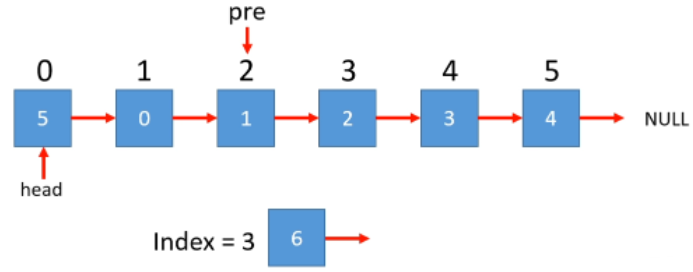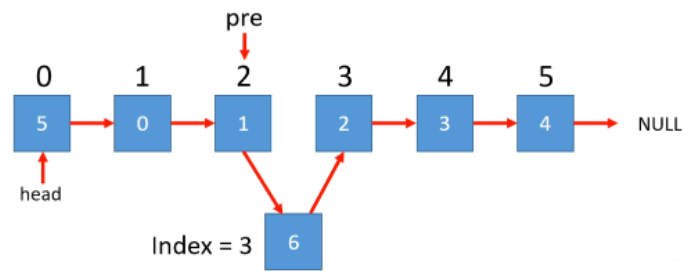定义
链表是一种常见的重要的数据结构。它是动态地进行存储分配的一种结构。
链表和数组比较,不用事先确定存储空间,而是根据需要开辟内存单元。
表现示例

第0个结点称为头结点,它存放有第一个结点的首地址,它没有数据,只是一个指针变量。
以下的每个结点都分为两个域。
- 一个是数据域,存放各种实际的数据, 如学号num, 姓名name, 性别sex和成绩score等。
- 一个域为指针域, 存放下一结点的首地址。链表中的每一个结点都是同一种结构类型
优势
链表可以动态的进行存储分配,也就是说,链表是一个功能极为强大的数组,他可以在节点中定义多种数据类型,还可以根据需要随意增添,删除,插入节点。
链表都有一个头指针, 一般以head来表示,存放的是一个地址。链表中的节点分为两类,头结点和一般节点,头结点是没有数据域的。链表中每个节点都分为两部分,一个数据域,一个是指针域。
名称注释
首节点
存放第一个有效数据的节点头节点:在单链表的第一个结点之前附设一个结点,它没有直接前驱,称之为头结点,头结点的数据域可以不存储任何信息,指针域指向第一个节点(首节点)的地址。头结点的作用是使所有链表(包括空表)的头指针非空
头指针
尾节点
尾指针
指向尾节点的指针
链表就如同车链子一样, head指向第一个元素:第一个元素又指向第二个元素;……,直到最后一个元素,该元素不再指向其它元素,它称为“表尾”,它的地址部分放一个“NULL”(表示“空地址”) , 链表到此结束。
作为有强大功能的链表,对他的操作当然有许多,比如:链表的创建,修改,删除,插入,输出,排序,反序,清空链表的元素,求链表的长度等等。
操作
链表中添加结点
链表头部插入结点(头插法)
假设有以下链表
建立一个新结点,它的下一结点指向nullNode node = new Node(5);
把新结点的下一结点指向head结点node.next = head;
更新头结点,head指向新结点head = node;
完成往链表头部插入结点
往链表中间或尾部插入结点

假设往结点1后插入新结点6,找到结点1的下一结点指向6,6的下一结点指向结点2即可
Node pre = head;for(int i = 0; i < index - 1; i++){pre = pre.next;}

Node node = new Node(6);node.next = pre.next;
查询链表中的结点

利用临时变量curNode cur = head;
for(int i = 0; i < index; i++)cur = cur.next;
删除链表中的结点
删除链表头部结点

删除结点5,只需把头结点指向结点5的下一结点head = head.next;
结点5没有引用会被回收。
删除链表中间或尾部的结点
假设要删除索引位置3的结点
Node pre=head;for(int i = 0; i < index - 1; i++){pre = pre.next;}
Node delNode = pre.next;pre.next = delNode.next;
删除链表中指定的结点
假如删除结点6
临时变量cur结点指向head,临时pre结点指向null
pre = cur;cur = cur.next;
具体代码实现
using System;using System.Collections.Generic;using System.Text;namespace LinkedList{class LinkedList1<E> // 泛型链表类{// 结点内部类private class Node{public E e; // 存储的元素epublic Node next; // 当前结点的下一个结点// 构造函数初始化public Node(E e, Node next){this.e = e;this.next = next;}// 没有下一结点的构造public Node(E e){this.e = e;this.next = null;}// 打印输出public override string ToString(){return e.ToString();}}// 链表头部private Node head;// 存储的元素个数private int N;// 构造函数public LinkedList1(){head = null;N = 0;}// 属性:链表元素个数public int Count{get { return N; }}// 属性:是否为空public bool IsEmpty{get { return N == 0; }}// 插入结点public void Add(int index, E e){if (index < 0 || index > N){throw new ArgumentException("非法索引");}// 往头部插入结点if (index == 0){Node node = new Node(e); // 创建新结点node.next = head; // 新结点next指向头结点head = node; // 更新头结点//head = new Node(e, head); 这里复用了之前写的public Node(E e,Node next)构造方法,等同于上面三行代码一样}// 往中间或尾部插入else{Node pre = head; // 临时结点prefor (int i = 0; i < index - 1; i++) // 找到要插入的索引位置的结点的前一个结点{pre = pre.next;}Node node = new Node(e); // 创建新结点node.next = pre.next; // 新结点指向临时结点下一结点pre.next = node; // 更新临时结点下一结点指向新结点//pre.next = new Node(e, pre.next); 同理等同于上面三句代码}N++;// 链表元素个数更新}// 头部插入public void AddFirst(E e){Add(0, e);}// 尾部插入public void AddLast(E e){Add(N, e);}// 查询结点public E Get(int index){if (index < 0 || index >= N){throw new ArgumentException("非法索引");}Node cur = head; // 临时变量结点cur指向结点head// 找到对应索引结点for (int i = 0; i < index; i++){cur = cur.next;}return cur.e;}public E GetFirst(){return Get(0);}public E GetLast(){return Get(N - 1);}// 修改结点元素public void Set(int index, E newE){if (index < 0 || index >= N)throw new ArgumentException("非法索引");Node cur = head; // 临时变量结点cur指向结点head// 找到对应索引结点for (int i = 0; i < index; i++){cur = cur.next;}cur.e = newE;}// 判断包含public bool Contains(E e){Node cur = head;while (cur != null){// 如果结点与元素相同返回trueif (cur.e.Equals(e)){return true;}cur = cur.next;}return false;}public E RemoveAt(int index)//删除{if (index < 0 || index >= N)throw new ArgumentException("非法索引");//删除头结点if (index == 0){Node delNode = head; // delNode指向head结点head = head.next; // 更新头结点N--;return delNode.e; // 返回被删除的结点元素}else{Node pre = head;// 找到删除索引结点的前一个结点for (int i = 0; i < index - 1; i++)pre = pre.next;Node delNode = pre.next; // delNode指向pre结点的下一个结点pre.next = delNode.next; // pre下一个结点指向delNode的下一个结点N--;return delNode.e;}}public E RemoveFirst(){return RemoveAt(0);}public E RemoveLast(){return RemoveAt(N - 1);}public void Remove(E e){// 头结点空,说明链表没有结点if (head == null){return;}// 删除的元素是头结点if (head.e.Equals(e)){head = head.next;N--;}else{Node cur = head;Node pre = null;// 查找要删除的元素的结点while (cur != null){// 找到元素退出循环if (cur.e.Equals(e)){pre.next = cur.next; // pre下一结点指向cur的下一结点break;}pre = cur;cur = cur.next;}//if (cur != null)//{// pre.next = pre.next.next; // pre下一结点指向cur的下一结点// N--;//}}}// 打印输出public override string ToString(){StringBuilder res = new StringBuilder();Node cur = head;while (cur != null){res.Append(cur + "->");cur = cur.next;}res.Append("Null");return res.ToString();}}}
using System;namespace LinkedList{class Program{static void Main(string[] args){// 创建链表LinkedList1<int> l = new LinkedList1<int>();for (int i = 0; i < 5; i++){l.AddFirst(i); // 头部插入Console.WriteLine(l);}l.AddLast(60); // 尾部插入Console.WriteLine("尾部插入");Console.WriteLine(l);l.Add(2, 99);Console.WriteLine("索引2位置插入99结点");Console.WriteLine(l);l.Set(1, 100);Console.WriteLine("修改索引1位置的结点元素");Console.WriteLine(l);l.RemoveAt(2);Console.WriteLine("删除索引2位置的结点");Console.WriteLine(l);l.RemoveFirst();Console.WriteLine("删除头结点");Console.WriteLine(l);l.RemoveLast();Console.WriteLine("删除尾部结点");Console.WriteLine(l);l.Remove(0);Console.WriteLine("删除结点0");Console.WriteLine(l);Console.Read();}}}





